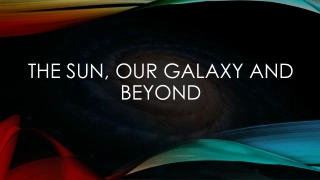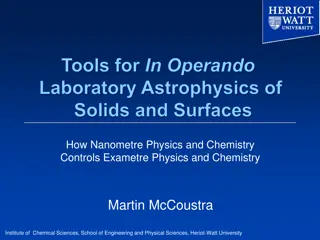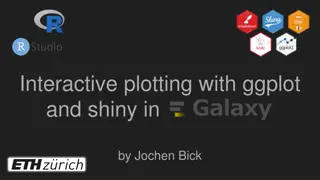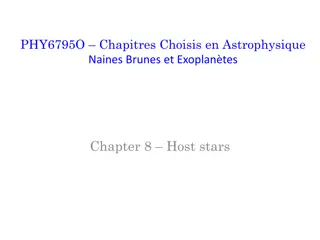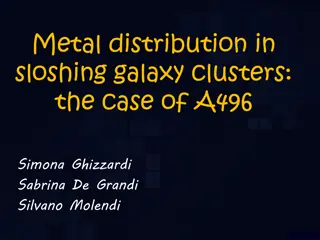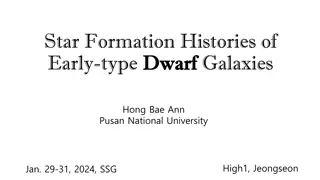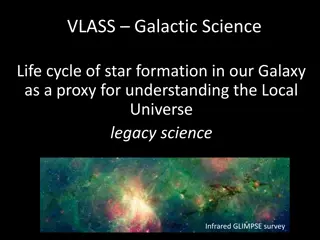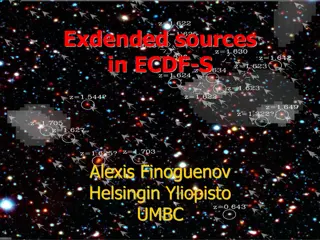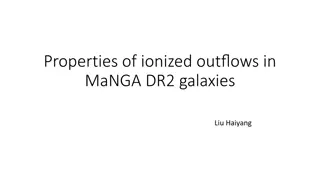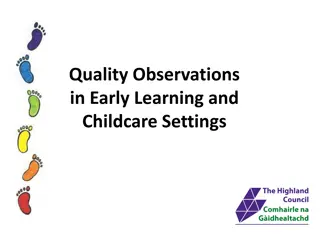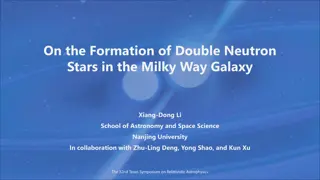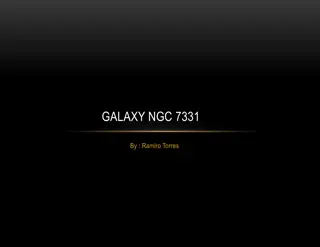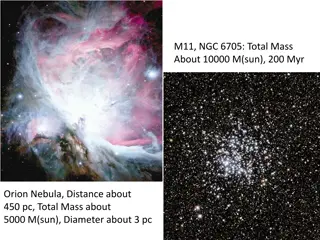Implications of Star Formation in the Central Parsec of Our Galaxy with Subaru Observations
Researchers presented implications of star formation in the central parsec of our Galaxy using Subaru observations at the 2014 Subaru Users Meeting. The study focused on the supermassive black hole Sgr A* and the challenges posed by conditions in the Galactic Center for star formation. Various scenarios of star formation were discussed, including in-situ formation, infalling stellar clusters, and the role of young stellar objects as a key to understanding star formation in the Galactic Center. Polarimetric observations were highlighted as a method for searching for young stellar objects.
Download Presentation

Please find below an Image/Link to download the presentation.
The content on the website is provided AS IS for your information and personal use only. It may not be sold, licensed, or shared on other websites without obtaining consent from the author. Download presentation by click this link. If you encounter any issues during the download, it is possible that the publisher has removed the file from their server.
E N D
Presentation Transcript
Implication for star formation in the central parsec of our Galaxy with Subaru observations Tatsuhito Yoshikawa (Kyoto Univ.) Shogo Nishiyama, Motohide Tamura, Miki Ishii , Naoto Emi, Hiroto Kawabata and Tetsuya Nagata 2014 Subaru Users Meeting 2014/01/21-23 @Mitaka, NAOJ
INTRODUCTION MOTIVATION
1/15 Central parsec of Our Galaxy (GC) super massive black hole, Sgr A* (M ~ 4 106Msun, d~8kpc) mini spiral & circumnuclear disk many (>100) young massive stars (OB, Wolf-Rayet star) (e.g., Gillessen+ 09) (e.g., Paumard+ 06, Bartko+ 09, Lu+ 09) H92 (8.3GHz) H(1.65um)+Ks(2.16um)+L (3.76um) 0.05 (400AU) Sgr A* Sgr A* SMBH ~4 106Msun 50 (2pc) 10 (0.39pc) ESO/VLT (Genzel+ 03) NTT, VLT & Keck (Gillessen+ 09) VLA (Roberts & Goss 1993)
2/15 young stars in the GC young ( 3Myr) massive stars in the GC (e.g, Krabbe+ 95) = star formation occurred in the GC 3Myr ago BUT Sgr A* strong tidal force shear molecular clouds difficult conditions for star formation (Morris 93) n~109/cm3at 10 (0.4pc) cf. molecular cloud (10K) 104/cm3 molecular cloud core 105/cm3 What is the origin of young stars in the GC?
3/15 scenarios of star formation 1. in-situ star formation (e.g., Genzel+ 03) 2. infalling stellar cluster (e.g., Gerhard 01) cluster SMBH SMBH ~30 pc disk ~1 pc collision of molecular clouds loss of angular momentum gas infall (accretion) star formation in the disk star formation far from Sgr A* as a stellar cluster the stellar cluster falls into the GC by dynamical friction
4/15 YSO is the key for young stars in the GC <Motivation> infall timescale: 3Myr (~ the age of young star in the GC) (condition: Mcluster~106Msun, Rg~30pc(Gerhard 01, Kim & Morris 03)) cf. Arches or Quintuplet ~104Msun, 30pc (e.g., Figer+ 99) The existence of younger objects (<1Myr) can reject infalling stellar cluster scenario! younger objects: Young Stellar Object (YSO) with circumstellar disk target: Herbig Ae/Be stars lifetime of disk is <1Myr (Alonso-Albi+ 09) method: polarimetric observations
5/15 YSO search with polarimetric observations scattering polarization (Whitney & Hartmann 92) scattered light direct starlight central star re-emission infrared excess (red) circumstellar disk intrinsic polarization = circumstellar disk YSO
OBSERVATION ANALYSIS
6/15 observation 17 (~0.7pc) Subaru/CIAO+AO36 (21.7mas/pix) 2008/05/26-28 Ks band Sgr A* DEC polarimetric observation 1/2 waveplate wire grid polarizer 20 sec 189 sets RA
7/15 data analysis software: IRAF/DAOPHOT ordinary data reduction (dark, flat, sky, bad pixel correction) PSF photometry + aperture correction for each night check the reproducibility through three nights remove no-reproducibility stars 318-stars polarization (mKs<15.5, P<1%) ( 0 I Q = ) = + + + 2 I I I I I 22 5 . 45 67 5 . = I + Stokes Parameters: 0 45 U I I 22 5 . 67 5 .
8/15 intrinsically polarized stars are found qu diagram 0.12 degree of polarization: 2 2 Q U = + 0.08 P I I U/I polarization angle 0.04 1 U = arctan 2 Q polarization angle 0 (TY+ 13) 0 0.04 0.08 0.12 Q/I
9/15 intrinsically polarized stars are found qu diagram 0.12 degree of polarization: 2 2 Q U = + 0.08 P I I intrinsic polarization U/I 0.04 observed polarization polarization angle 1 U = arctan 2 Q interstellar polarization 0 (TY+ 13) 0 0.04 0.08 0.12 Q/I
10/15 intrinsically polarized stars are found qu diagram 0.12 2 2 = + _ pol error spread #6 #1 0.08 spread of data points #5 U/I intrinsically polarized stars are found! >3 : 11 0.04 #4 #11 #2 #8 #9 #10 #7 0 #3 photometric error (TY+ 13) 0 0.04 0.08 0.12 Q/I
11/15 intrinsically polarized stars are found #1 8 2 2 = + #3 #4 _ pol error spread #8 4 #7 DEC[arcsec] intrinsically polarized stars are found! >3 : 11 #9#10 0 #2 #6 #11 -4 -8 #5 8 4 0 -4 -8 (TY+ 13) RA[arcsec]
12/15 color of intrinsically polarized stars color-color diagram 4.5 YSO red color (infrared excess) (TY+ 13) 4 7 polarized stars are red (infrared excess) 3.5 #6 YSO #11 3 H-Ks #7 polarization + color certain YSO candidates #5#8 2.5 #4 #3 #1 2 #2 AKs=1 #9 1.5 >3 polarized star --- color of early-type dwarf late-type giants --- color of T Tauri star HKsL from Scho del+ 10 1 1 1.5 2 2.5 3 3.5 4 4.5 Ks-L
13/15 ALMA finds YSO candidates in the GC ALMA finds 11 SiO clumps in the GC SiO clump reflects outflow from massive protostar (Yusef-Zadeh+ 13) (Gibb+ 04, 07) 8 SiO clump t~104-105yr (line ratio) polarized stars t<105yr (brightness) DEC[arcsec] 4 0 clump 1 (Yusef-Zadeh+ 13) clump 1 (Yusef-Zadeh+ 13) our YSO candidate (#2) -4 latest on going in-situ star formation -8 8 4 0 -4 -8 RA[arcsec]
14/15 Spectroscopic observations Subaru/IRCS+AO188 (52mas/pix) 2013/05/21, 22 grism mode (K-band filter) R=1200 #11 Br Intensity 2.0 2.2 2.4 wavelength [ m]
15/15 Summary young massive stars in the central parsec of our Galaxy (in situ star formation? inspiraling stellar cluster?) YSO is the key to solve this question near-infrared polarimetry with Subaru/CIAO+AO36 find intrinsically polarized stars (>3 : 11) color 7 good YSO candidates ALMA find the counterpart of one of our YSO candidates in-situ star formation is acceptable spectroscopic observations with Subaru/IRCS+AO188 under analysis Thank you! Thank you!
YSO or DES? mini spiral DES (Dust Embedded Source) (e.g., Eckart+ 95, Ott+99) distributed along mini spiral nearly featureless near-infrared spectra red color intrinsically polarized the same characteristics as YSO observational field (Roberts & Goss 93) DES YSO (Tanner+ 02, 05) some DESs are not YSOs but windy massive stars heating surrounding dust red color scattered by surrounding dust polarization DES with bow shock How about our YSO candidates? (Geballe+ 04)
YSO or DES? <reported DES> IRS 21, 10W: >3 polarized, red IRS 1W: not measured IRS 5, 8: out of field IRS 10W our YSO candidates within mini spiral new DESs? far from mini spiral YSO candidates need spectroscopy! Subaru/IRCS (2012/06/17) IRS 1W DEC IRS 21 2-3 : red stars >3 RA
104Msun 106Msun 3pc 0.051Myr 0.11-0.19pc SMBH D 0.6-0.76 1.5pc e=0-0.53 a=0.13pc 105Msun Bonnel et al. 2008
3.5pc 50K 104cm-3 8.81 5pc 104Msun 0.25Myr 0.75-6.95 0.24-0.51 1-1.7pc 104Msun Alig et al. 2009
3.4 2.6 0.12, 0.39 (25, 0, 0), (22, 6, 7) 104Msun 104Msun (0.06Myr) cooling time 2.4pc SMBH 2 Hobbs & Nayakshin 2009
spread of data points Q/I U/I
interstellar polarization B star aligned dust unpolarized polarized observer
Spectroscopic observations Subaru/IRCS+AO188 (52mas/pix) 2013/05/21, 22 grism mode (K-band filter) R=1200 #5 Intensity CO (v=2-0) 2.0 2.2 2.4 wavelength [ m]


